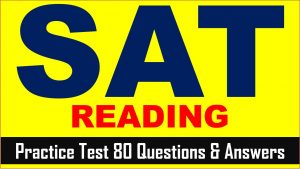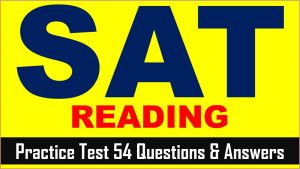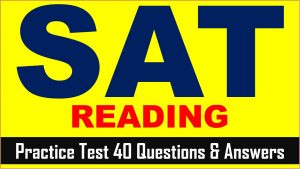SAT (Scholastic Assessment Test) is a standard test, used for taking admission to undergraduate programs of universities or colleges of the United States. SAT is developed and published by the College Board, an organization in the United States, administered by the Educational Testing Service. In this article of AKVTutorials, you will get SAT Reading Comprehension Practice Test 45 | SAT 2024 Online Tutor AMBiPi.
SAT Reading Practice Passage
Passage 1 is adapted from Brian Handwerk, “A New Antibiotic Found in Dirt Can Kill Drug-Resistant Bacteria.” ©2015 by Smithsonian Institution. Passage 2 is adapted from David Livermore, “This New Antibiotic Is Cause for Celebration—and Caution.” ©2015 by Telegraph Media Group Limited.
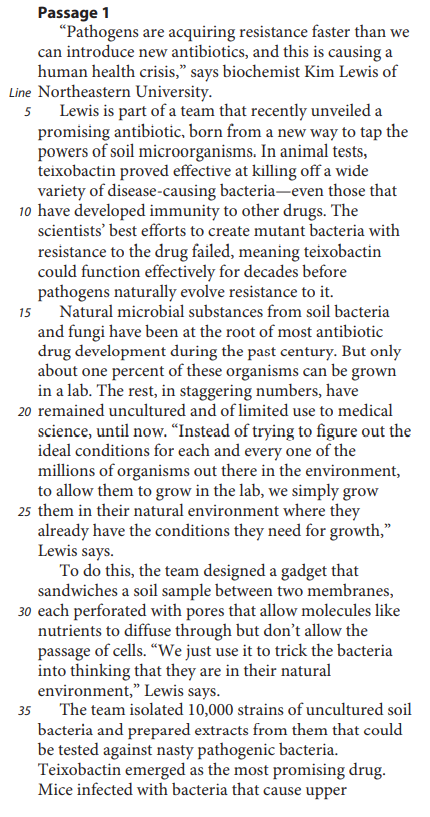
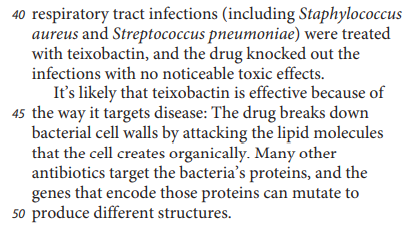
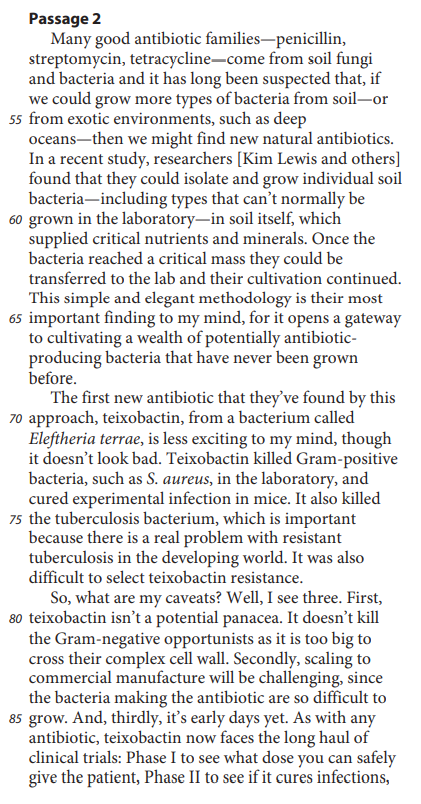

SAT Reading Comprehension Practice Test Questions
SAT Practice Test 45 Question No 1
The first paragraph of Passage 1 primarily serves to
Option A: present a claim that is supported and developed over the course of the passage.
Option B: introduce a controversy that the study described in the passage is intended to resolve.
Option C: identify a problem that the research discussed in the passage may help to address.
Option D: offer a theory that is challenged by the findings presented in the passage.
SAT Practice Test 45 Answer No 1
Show/Hide Answer
Option C :
The first paragraph of Passage 1 presents a quote by biochemist Kim Lewis of Northeastern University: “Pathogens are acquiring resistance faster than we can introduce new antibiotics, and this is causing a human health crisis.” The rest of the passage describes Lewis’s research and the experimental antibiotic called teixobactin that her research has produced. According to the second paragraph of the passage, teixobactin has “proved effective at killing off a wide variety of disease-causing bacteria—even those that have developed immunity to other drugs.” Therefore, the first paragraph of Passage 1 primarily serves to identify a problem that the research discussed in the passage may help to address.
Choice A is incorrect because although the first paragraph quotes a claim by Lewis regarding antibiotic resistance, this claim isn’t developed over the course of Passage 1. Choice B is incorrect because the claim made in the first paragraph regarding antibiotic resistance isn’t presented as controversial, nor does Passage 1 attempt to resolve any scientific controversies. Choice D is incorrect because the claim made in Paragraph 1 isn’t presented as a theory; moreover, the findings in Passage 1 support this claim rather than challenge it.
SAT Practice Test 45 Question No 2
The author of Passage 1 suggests that an advantage of the method Lewis’s team used to grow microorganisms is that it
Option A: identifies the requirements for soil bacteria to thrive and replicates those features in artificial soil.
Option B: enables soil bacteria to take in more nutrients than they typically consume in natural settings
Option C: directly affects the cell walls of bacteria rather than the proteins those bacteria produce.
Option D: allows researchers to make use of soil bacteria that they had previously been unable to exploit.
SAT Practice Test 45 Answer No 2
Show/Hide Answer
Option D :
The third paragraph of Passage 1 describes how, historically, the development of antibiotics requires “natural microbial substances,” but this reliance has severe limitations as only about one percent of these microbial substances can be grown in a laboratory. The author goes on to explain how “the rest, in staggering numbers, have remained uncultured and of limited use to medical science, until now.” The paragraph then describes the method Lewis’s team used to grow teixobactin microorganisms “in their natural environment where they already have the conditions they need for growth.” Therefore, the author of Passage 1 suggests that an advantage of the method Lewis’s team used to grow microorganisms is that it allows researchers to make use of soil bacteria that they had previously been unable to exploit.
Choice A is incorrect because although the author of Passage 1 suggests that Lewis’s team identified the requirements for soil bacteria to thrive, the team didn’t replicate those features in artificial soil. Instead, the author suggests in the third and fourth paragraphs of Passage 1 that they used real soil samples. Choice B is incorrect because the author of Passage 1 doesn’t suggest that the method Lewis’s team used to grow microorganisms enabled soil bacteria to take in more nutrients than they typically consume in natural settings. Instead, it can be inferred from the fourth paragraph of the passage that the bacteria were provided with the same nutrients they consume in natural settings. Choice C is incorrect because the last paragraph of Passage 1 explains that it isn’t the method Lewis’s team used to grow bacteria but the antibiotic the team created that affects the cell walls of bacteria.
SAT Practice Test 45 Question No 3
Which choice provides the best evidence for the answer to the previous question?
Option A: Lines 17-21 (“But only… now”)
Option B: Lines 28-32 (“To do… cells”)
Option C: Lines 32-34 (“We just… says”)
Option D: Lines 44-47 (“It’s likely… organically”)
SAT Practice Test 45 Answer No 3
Show/Hide Answer
Option A :
The previous question asks what advantage of the method Lewis’s team used to grow microorganisms is suggested by the author of Passage 1. The answer, that this method allows researchers to make use of soil bacteria that they had previously been unable to exploit, is best supported by the first through third sentences of the third paragraph of Passage 1: “Natural microbial substances from soil bacteria and fungi have been at the root of most antibiotic drug development during the past century. But only about one percent of these organisms can be grown in a lab. The rest, in staggering numbers, have remained uncultured and of limited use to medical science, until now.”
Choices B, C, and D are incorrect because the cited lines don’t support the answer to the previous question. Instead, they describe the gadget that Lewis’s team developed to grow microorganisms (choice B), explain how the team’s technique affects the bacteria (choice C), and outline how teixobactin attacks harmful bacteria (choice D).
SAT Practice Test 45 Question No 4
The author of Passage 2 would most likely agree with which statement about the development of teixobactin?
Option A: It reveals that some antibiotics are effective against gram-negative bacteria.
Option B: It shows that conventional methods can still yield new types of antibiotics.
Option C: It casts doubt on the practicality of searching for new antibiotics in exotic environments.
Option D: It confirms a long-held belief about a potential source of new antibiotics.
SAT Practice Test 45 Answer No 4
Show/Hide Answer
Option D :
In the first sentence of Passage 2, the author outlines the “long . . . suspected” belief that if researchers could “grow more types of bacteria from soil . . . then we might find new natural antibiotics.” The author then explains how Lewis’s team’s technique that led to the development of teixobactin employed growing bacteria from soil. The author concludes in the last sentence of the first paragraph that Lewis’s team’s “simple and elegant methodology . . . opens a gateway to cultivating a wealth of potentially antibiotic-producing bacteria.” Therefore, the author of Passage 2 would most likely agree with the statement that the development of teixobactin confirms a long-held belief about a potential source of new antibiotics.
Choice A is incorrect because the author of Passage 2 wouldn’t likely agree with the statement that the development of teixobactin reveals that some antibiotics are effective against gram-negative bacteria. The author mentions gram-negative bacteria in the third paragraph to highlight teixobactin’s ineffectiveness in combating it, not to discuss other antibiotics that are effective against gram-negative bacteria. Choice B is incorrect because the author wouldn’t likely agree with the statement that the development of teixobactin shows that conventional methods can still yield new types of antibiotics. Instead, the author contends that the unconventional method used to produce teixobactin may yield new types of antibiotics. Choice C is incorrect because the author wouldn’t likely agree with the statement that the development of teixobactin casts doubt on the practicality of searching for new antibiotics in exotic environments. Rather, in the first paragraph of Passage 2, the author states that exotic environments might yield new antibiotics.
SAT Practice Test 45 Question No 5
As used in line 79, “caveats” most nearly means
Option A: exceptions.
Option B: restrictions.
Option C: misgivings.
Option D: explanations.
SAT Practice Test 45 Answer No 5
Show/Hide Answer
Option C :
In the first sentence of the last paragraph of Passage 2, the author expresses reservations about the immediate usefulness of teixobactin: “So, what are my caveats? Well, I see three. First, teixobactin isn’t a potential panacea. . . . Secondly, scaling to commercial manufacture will be challenging. . . . And, thirdly . . . teixobactin now faces the long haul of clinical trials.” The author uses the word “caveats” to introduce skeptical comments about teixobactin’s value. Thus, the word “caveats,” as used in the first sentence of the last paragraph of Passage 2, most nearly means misgivings.
Choices A, B, and D are incorrect because in the context of the passage, “caveats” means misgivings, not exceptions (choice A), restrictions (choice B), or explanations (choice D).
SAT Practice Test 45 Question No 6
In the last sentence of Passage 2, the author uses the phrase “five years and £500 million” primarily to
Option A: emphasize the scale of the effort needed to make teixobactin available for consumer use.
Option B: criticize the level offunding that the government has committed to teixobactin development.
Option C: underscore the amount oftime and money that has already been spent researching teixobactin.
Option D: underscore the amount oftime and money that has already been spent researching teixobactin.
SAT Practice Test 45 Answer No 6
Show/Hide Answer
Option A :
In the last paragraph of Passage 2, the author expresses reservations regarding teixobactin. One of these reservations is that the drug “now faces the long haul of clinical trials” before teixobactin can be made available for consumers. These clinical trials will be used to discover “what dose you can safely give the patient . . . if it cures infections, and . . . to compare its efficacy to that of ‘standard of care treatment,’” and are “going to take five years and £500 million.” Thus, the author uses the phrase “five years and £500 million” primarily to emphasize the scale of the effort needed to make teixobactin available for consumer use.
Choices B, C, and D are incorrect because the author of Passage 2 uses the phrase “five years and £500 million” as a reference to the time and financial commitment that will be required to make teixobactin available to the public. That being the case, the phrase doesn’t imply criticism of the level of funding that the government has committed to teixobactin development (choice B), address the amount of time and money that has already been spent researching teixobactin (choice C), or compare the amount of money spent developing teixobactin with the amount spent developing other antibiotics (choice D).
SAT Practice Test 45 Question No 7
Which choice best describes the relationship between Passage 1 and Passage 2?
Option A: Passage 2 offers an evaluation of the significance of the research discussed in Passage 1.
Option B: Passage 2 suggests a modification to the methodology described in Passage 1.
Option C: Passage 2 uses concrete examples to illustrate concepts considered in Passage 1.
Option D: Passage 2 takes a dismissive stance regarding the findings mentioned in Passage 1.
SAT Practice Test 45 Answer No 7
Show/Hide Answer
Option A :
Passage 1 discusses research conducted by biochemist Kim Lewis. As described in the second paragraph of the passage, this research explored “a new way to tap the powers of soil microorganisms” in the laboratory and led to the development of teixobactin, a promising new drug that could “function effectively for decades,” thereby addressing the problem of pathogens’ resistance to antibiotics. The author of Passage 2 critiques the research described in Passage 1. In the first paragraph of Passage 2, the author declares that the methodology Lewis and others developed “is their most important finding . . . for it opens a gateway to cultivating a wealth of potentially antibiotic-producing bacteria.” However, teixobactin “is less exciting” to the author of Passage 2 because it has proved ineffective at combating certain types of bacteria and large investments of time and money will be needed before it can be made available to the public at large, according to the second and third paragraphs of Passage 2. Therefore, the best description of the relationship between Passage 1 and Passage 2 is that Passage 2 offers an evaluation of the significance of the research discussed in Passage 1.
Choice B is incorrect because Passage 2 doesn’t suggest a modification to the methodology described in Passage 1. Instead, the author of Passage 2 embraces the “simple and elegant” methodology described in Passage 1. Choice C is incorrect because Passage 2 doesn’t use concrete examples to illustrate concepts considered in Passage 1. Instead, it evaluates the significance of the research. Choice D is incorrect because Passage 2 doesn’t take a dismissive stance regarding the findings mentioned in Passage 1. The author of Passage 2 endorses the methodology described in Passage 1, and concedes that teixobactin “doesn’t look bad,” while outlining some reservations about the drug’s value.
SAT Practice Test 45 Question No 8
Both passages make the point that teixobactin could be useful in
Option A: standardizing the future development of antibiotics produced in laboratory environments.
Option B: combating infections that are no longer responding to treatment with other antibiotics.
Option C: controlling the spread of pathogenic soil fungi.
Option D: controlling the spread of pathogenic soil fungi.
SAT Practice Test 45 Answer No 8
Show/Hide Answer
Option B :
The first paragraph of Passage 1 quotes biochemist Kim Lewis of Northeastern University: “Pathogens are acquiring resistance faster than we can introduce new antibiotics, and this is causing a human health crisis.” However, research conducted by Lewis has produced a drug called teixobactin, which has “proved effective at killing off a wide variety of disease-causing bacteria—even those that have developed immunity to other drugs,” according to the second sentence of the second paragraph of Passage 1. Similarly, in the third sentence of the second paragraph of Passage 2, the author of the passage states that teixobactin “killed the tuberculosis bacterium, which is important because there is a real problem with resistant tuberculosis in the developing world.” Therefore, both passages make the point that teixobactin could be useful in combating infections that are no longer responding to treatment with other antibiotics.
Choice A is incorrect because Passage 1 outlines the methodology used to produce teixobactin but doesn’t offer it as a model for future development of antibiotics produced in laboratory environments. Passage 2 suggests that future development of antibiotics may draw on the methodology that Lewis and others developed, but the passage doesn’t go so far as to suggest that teixobactin could be used to standardize this development. Choices C and D are incorrect because neither passage makes the point that teixobactin could be useful in controlling the spread of pathogenic soil fungi (choice C) or in shaping a new method of studying the effectiveness of antibiotics (choice D).
SAT Practice Test 45 Question No 9
Information in Passage 2 best supports which conclusion about the mice in the experiment described in Passage 1?
Option A: Exposure to teixobactin made them less susceptible to subsequent upper respiratory tract infections.
Option B: Gram-positive bacteria enhanced the effectiveness of teixobactin against their upper respiratory tract infections.
Option C: Their upper respiratory tract infections were likely not caused by gram-negative bacteria.
Option D: Teixobactin attacked the proteins of the bacteria that caused their upper respiratory tract infections.
SAT Practice Test 45 Answer No 9
Show/Hide Answer
Option C :
According to the last sentence of the fifth paragraph of Passage 1, “Mice infected with bacteria that cause upper respiratory tract infections . . . were treated with teixobactin, and the drug knocked out the infections with no noticeable toxic effects.” The second paragraph of Passage 2 explains that teixobactin was tested in a laboratory and killed gram-positive bacteria, but, according to the fourth sentence of the third paragraph, it “doesn’t kill the Gram-negative opportunists as it is too big to cross their complex cell wall.” Therefore, since teixobactin was not successful in eradicating gram-negative bacteria as stated in Passage 2, this information best supports the conclusion that the mice described in the experiment in Passage 1 had upper respiratory tract infections that were likely not caused by gram-negative bacteria since these infections were successfully treated by teixobactin.
Choices A, B, and D are incorrect because no information in Passage 2 supports the conclusion that the mice in the experiment described in Passage 1 were less susceptible to subsequent upper respiratory tract infections due to exposure to teixobactin (choice A), the gram-positive bacteria enhanced the effectiveness of teixobactin against the upper respiratory tract infections in the mice (choice B), or the teixobactin attacked the proteins of the bacteria that caused the upper respiratory tract infections in the mice.
SAT Practice Test 45 Question No 10
Which choice provides the best evidence for the answer to the previous question?
Option A: Lines 51-56 (“Many… antibiotics”)
Option B: Lines 64-68 (“This… before”)
Option C: Lines 69-72 (“The first… bad”)
Option D: Lines 80-82 (“It doesn’t… wall”)
SAT Practice Test 45 Answer No 10
Show/Hide Answer
Option D :
The previous question asks which conclusion about the mice in the experiment described in Passage 1 is best supported by information in Passage 2. The answer, that their upper respiratory tract infections were likely not caused by gram-negative bacteria, is best supported by the fourth sentence of the third paragraph of Passage 2: “[Teixobactin] doesn’t kill the Gram-negative opportunists as it is too big to cross their complex cell wall.”
Choices A, B, and C are incorrect because the cited lines don’t support the answer to the previous question. Instead, they provide a historical background to Lewis’s cultivation of soil bacteria (choice A), praise the methodology used by Lewis’s team and others (choice B), and introduce an evaluation of teixobactin (choice C).

